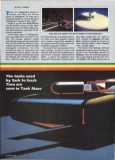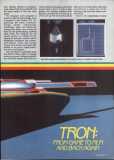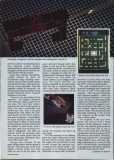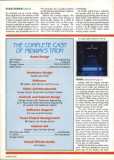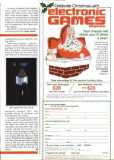There are videogames based on movies, and there are movies based on videogames. So why not a videogame based on a movie based on videogames? Sounds simple, right?
Forget it. By the time Bally/Midway had its finished version of the Tron-based coin-op, over fifteen skilled artisans had worked on well over 20 different assignments.
In the early days of videogames, each was pretty much one man's creation. The concept, graphics, visuals and ultimate programming were all the vision of one mind. But when you stop to think about the high-speed world of videogame production, it's only natural the age of teamwork and specialization had to dawn. And the trend isn't entirely motivated by hardly all financial and schedule considerations. After all, what are the odds of one person being a conceptual genius, an audio and video graphics wizard and a master programmer capable of accurately transcribing that vision into assembly language or BASIC?
The result is the development of the team concept. A nucleus of five or so honchos ride herd over a gathering of specialized computer entertainment talent, a system the Japanese have long used. Always quick to spot a good idea (they copped the U.S. rights to such smashes as Galaxian and Pac-Man), Midway started to sharpen its own software sword, a keen weapon with a double edge!
The brand new Midway software development group has not only produced such incredible games as Kickman, with its involving graphics, but is also turning out the new VCS-compatible CBS Video Games line as well. Midway intends to simultaneously release both the arcade title and the home version of the very same game!
The designers were assigned to projects under the Game Design Team composed of John Pasierb (V.P. Engineering), Bill Adams (software), George Gomez (mechanicals, storyboards, video and cabinet art, among other things — just to keep his hand in) and game-playing superstar Atish Ghosh, the hardware ace. Six people worked on nothing but designing the distinctive cabinet, with its holographic backboard and luminescent joystick. Along with George Gomez, John Marcus and Sharon Barr worked on the game's highly distinctive and varied graphics.
Once the talent was gathered, there was still the trifling matter of actually producing a game. Midway decided to let a free-lance design staff work on a version while its own group, which had proven itself in terms of both quality product and meeting deadlines with Kickman, produced an in-house try at a Tron coin-op. The two teams worked miles apart from each other with what amounted to a quick scan of the shooting script and a few reels of special effects.
Anyone even tangentially involved with the world of moviemaking knows that shooting scripts change, metamorphosize, melt and sometimes disappear entirely by the time the ultimate product hits the screens.
Using those sketchy foundations, Gomez started to work on storyboards — large drawings representing what the final framed camera shot should look like — that would depict the various playfields. They had originally wanted six sequences, but the four games that eventually evolved already stretched Atish's futuristic hardware to its limits.
"There was also the problem of the approach," one designer explained. "We obviously could've gone one of two ways. We could have concentrated on the actual arcade games at Flynn's (for those unfortunates who haven't seen Tron, Flynn is the game designer/User who enters the computer domain at the MCP's hard-to-turn-down-invitation). Unfortunately, the Space Paranoids sequence in the arcade doesn't utilize an actual game but just projects computer effects onto the monitor. In other words, we're a few years away from that level of visuals in videogames. The other approach, which we obviously went with, was to create games from the various game-type adventures Flynn has on the Game Grid."
Changes were rampant. At one point, deadly spores were to appear in the film. They were part of the Grid-Spiders scenario where Tron must make his way to the I/O tower, the great constructs through which data passes in and out of the computer. Sark, under the MCP's command, has shut down all the I/O towers and has begun a campaign to make the anthropomorphic Programs believe that the Users in the "real world" are merely mythical, quasi-religious delusions. The towers, therefore, are fiercely protected by the grid-spiders (seen for only an instant during the film's Solar Sailor sequence) which must be destroyed in order to enter the circular I/O transport and beam up into reality.
The Tank sequence of the Midway game may seem a little prosaic at first, but only until the arcader realizes that the angles must be perfected in order to pass through this particular test. "Going head-to-head is suicide," says ace gamer and hardware magician Atish with an impish smile. It becomes necessary to bank shots and keep moving as it takes three hits to destroy the MCP's armored dreadnaughts.
The most straightforward of the quartet of challenges that comprise the first rack of Tron is the Light-Cycle sequence. "This was just Checkmate with enhanced graphics," points out one of the team members. He is quite correct. On rack one, the player guides a light-cycle which leaves a solidly destructive wall behind it against a similarly armed cycle. The object is to stay alive longest, without running into anyone's walls. This scenario becomes especially intriguing at the second track, however, as the arcader must take on three cycles!
The toughest of the four mini-games may well be Tron's finest scenario. At the cataclysmic finale of the film, Tron, the last great warrior to fight for the Users and an ally of Flynn's, must hurl his disc at the whirling defensive wall the humanized MCP has throw up around itself. Ultimately, Flynn leaps into the MCP, disrupting it long enough for Tron — who was originally programmed as a sentry on the MCP! — to hurl his disk, containing the re-programmed information obtained at the I/O tower into the MCP.
Dealing with this highly dramatic moment in videogame terms proved a tough nut to crack, but Midway did themselves proud with their execution of a spinning cylinder, each stave colored differently, like a futuristic pickle barrel. The gamer must use his Tron surrogate to blast away at portions of the spinning cylinder. Of course, just as a side is cleared, the spinning brings the gamer face-to-face with undestroyed sections of the cylinder.
The most difficult overall assignment for the great game team, however, lay in the area of continuity. All the games had to have the same basic background and even use the same basic controllers. Gomez, Pasierb, Adams, Ghosh and cohorts decided on a grip-style joystick that would be lit from below to give it a fantastic bluish glow and a top-mounted action button. To aim Tron's weapons, a dial was positioned on the left side of the control console and is used in all but the Light-Cycles scenario, where players simply steer the cycle and hit the button to give 'er some speed.
Solving the backdrop problem was a cinch. The team decided to have the game play on the deadly Grid itself, overlaying the various segments onto that matrix.
There were problems, setbacks — Disney couldn't decide whether the good guys or the bad guys would be blue, for example — and mucho blood, sweat and tears, but the infant Midway Research & Development group eventually showed their final product — ahead of deadline — and were declared the winners.
The game is certainly strong enough to do well, with or without the film's success, just as many sound track Ip's are smash hits while the films they
score die at the box office. Still, early reports indicate that Disney is interested and encouraged enough that it's now working on Tron II. They're even toying with the idea of a third sequel. Should the film explode at the box office, the first great team-created coin-op will have an even stronger shot at super-hit status. But hit or miss with the film, Tron, the coin-op is a classic.
